A marketing funnel – the process of converting a potential customer to a paying one – is essential to the success of your business.
Marketing funnels are customer journey maps that show businesses what stage of the conversion process their customers are currently at – from “never heard of you before” to “totally buy again and recommend to all of my friends.”
Marketers who focus on improving their marketing funnels achieve far better results than their competitors.
This guide will show you what a digital marketing funnel is, all the steps to create a funnel, tools to assist in the process, and how to track success.
What is a Marketing Funnel, and Why Do You Need One?
Marketing funnels – sometimes called conversion funnels – is the art of moving a potential customer from the awareness stage to the action stage.
At the beginning of the marketing cycle (“awareness” stage), the pool of potential customers is broad, but as we get closer to the “decision” stage (to buy or not to buy), some customers drop off. You can visualize this process as a funnel (hence the name) – wide at the top and narrowing down from consideration to purchase.
There will always be more people in the awareness part of the funnel than actual paying customers, and that’s fine as long as you can identify leaks in your marketing funnel, improve conversion rates, and find ways to attract new prospects to the funnel.
Funnels are typically divided into three stages, though some marketers add additional levels after the conversion stage (for up-selling, cross-selling, and brand advocacy). To simplify things, we will cover only the three main ones in this article.
So, the main phases of a marketing funnel are:
● Upper Funnel Marketing: Awareness
● Mid Funnel Marketing: Interest and Evaluation
● Bottom Funnel Marketing: Decision and Sale
To maximize the efficiency of your marketing efforts, you need to track various types of conversions at each stage of the funnel. It will help you determine which parts of the funnel have leaks and need immediate fixing.
Marketing Funnel Stages for Effective Messaging
Each stage of a marketing funnel has a specific objective, both for the prospect and the marketer.
Stage #1 – Awareness (Top of the funnel/TOFU)
The upper part of the funnel is the awareness stage. At this stage, potential customers realise they have a problem or need and start looking for a solution.
Your prospect’s goal: Recognise a problem that needs to be solved, define possible solutions. For example, if they need proofread content for their website, they might consider hiring a proofreader or signing up for an AI grammar and spelling checking tool like Grammarly.
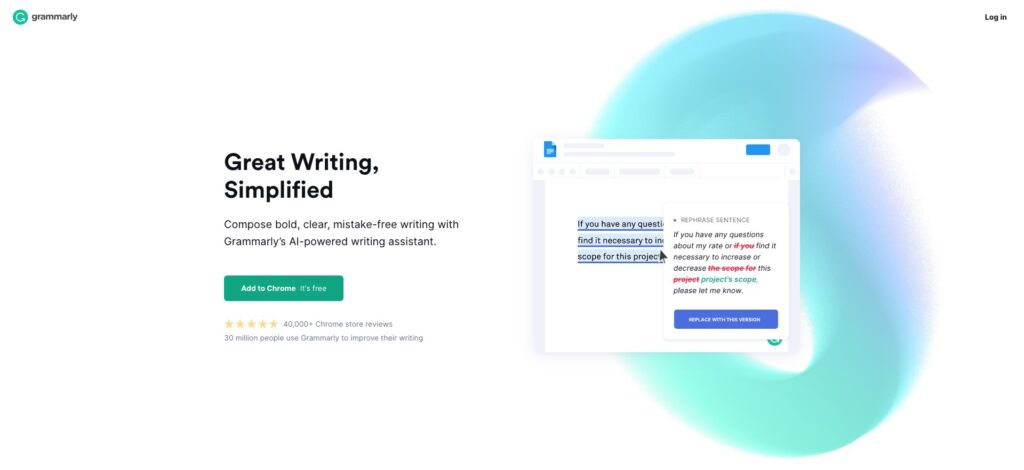
Your goal: Position your product as a possible solution to your potential customers’ problem, persuade them you’re an expert in the topic, educate and earn trust.
Marketing channels to use: If you have the budget, create content for all the channels your potential customers might use to do their research, then analyze the performance of your content and only leave those that deliver the best ROI.
If you are limited in budget or resources, concentrate on SEO, working with online communities/social media (Facebook, Instagram, Pinterest, Quora, Slack, ProductHunt, etc.), referral marketing, and YouTube.
Types of content for TOFU marketing
The right TOFU content should grab your prospects’ attention and show them that you have a solution for their problem.
So, here’s what you should use at this stage:
- Infographics
Infographics are natural eye-catchers and a great addition to your marketing funnel: they present the information that otherwise might be hard or boring to process in a fun, easy-to-consume way.
Include infographics in your content strategy if you want to get more social shares and build backlinks naturally.
Creating a share-worthy infographic isn’t exactly cheap (prices starting at 200$ if you hire a professional designer on Fiverr), so if you’re on a budget, try services like Canva or Visme.
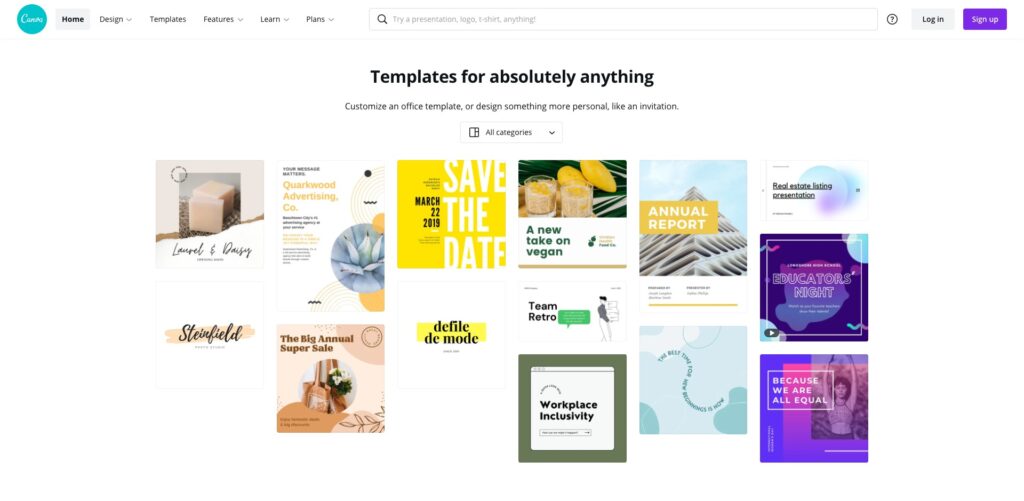
- SEO optimized blog posts
When researching topics and keywords for your TOFU blog posts, don’t get blinded by search volumes (aka “potential traffic”) but keep in mind the customer-content fit.
There’s no point in spending time and money creating and promoting a generic article that will bring you thousands of irrelevant site visitors that will never convert.
For example, suppose you are a B2B SaaS company offering project management software for small teams. In that case, you could use phrases like “how to prioritize work tasks” as a target keyword for a TOFU article. But if you are trying to sell something to the C-level managers (for example, consulting services), you need totally different content and an expertise level that most content writers simply don’t have.
Where do you get content and keyword ideas? There are dozens of online tools, both paid and free, but you could start with SemRush for keyword research and HubSpot for blog ideas generation.
- Landing pages
A landing page is a special page where your potential customers “land” after clicking on a paid ad or a link in a guest blog.
Your landing page copy needs to be precise and focused. If your product has multiple use cases or caters to different audiences, you might need to create more than one landing page.
To build a landing page, you may use services like Leadpages, Unbounce, or Wix. They require no coding skills (drag-and-drop interface), so your landing pages will be up and running in a matter of minutes.
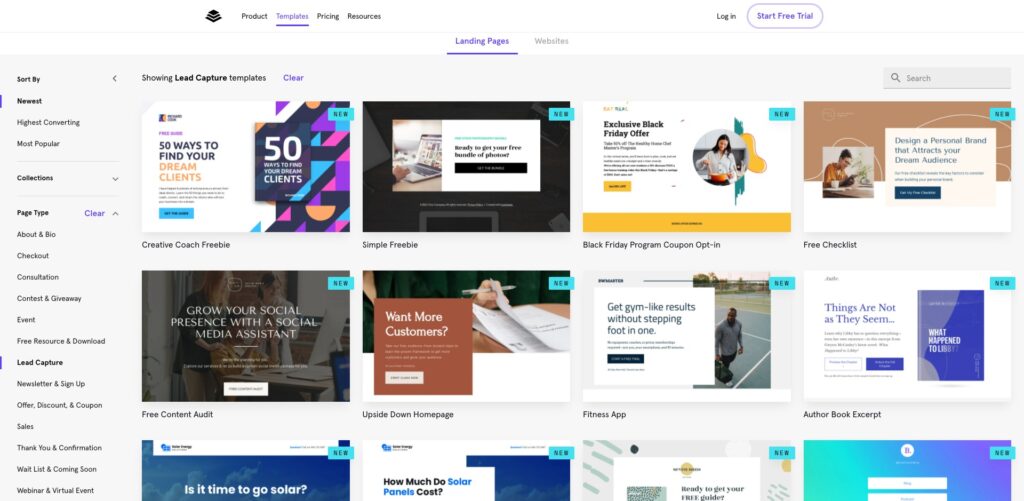
Once you design your landing page, you may use this free service to get an AI-powered heat map prediction of possible user-experience bottlenecks and design optimization suggestions.
Learn more:
16 mistakes to avoid when creating a landing page
- Search and social ads (Google, Facebook, Instagram, etc.)
You can only say so much in a search or a social media ad. So focus on the one thing your customer needs to know to quickly capture their interest. Make sure your landing page reflects that same message before you send the paid traffic to your website.
Conduct continuous A/B split testing to find ad copy that converts the most. Your motto should be “Theorize – Test – Analyze – Repeat” because split testing is a never-ending game.
You can leverage the power of artificial intelligence (AI) with services like Anyword, ABtesting.ai, CopyAI, Jarvis, and others to generate ad copy that will get higher conversion rates from the start.
- Guest blog posts
Offering free expert advice is one of the best ways to get noticed by potential customers and gain their trust. But how do you establish yourself as an expert and a thought leader? By leveraging the power of a third-party brand.
Do not waste your time (and money, if you’re hiring an outside copywriter) writing a blatant self-promotion piece: reputable media will not accept it, and those that will, won’t bring you any traffic or reputation.
- Webinars
You can use webinars throughout your marketing funnel, including post-sale stages, to increase customer’s LVT (lifetime value) and reduce churn.
Top-of-funnel webinars should be purely educational; they serve to share your expertise and establish trust.
Marketing your services or products right off the bat to the clients who have not decided what they want yet is not a smart move. You can offer them another piece of content (another webinar, checklist, etc.) that will delve deeper into the topic and introduce your product or service as an example/possible solution.
While some webinar hosting platforms only offer live webinars, others provide live, on-demand, and automated webinars (e.g., Demio, Livestorm, WebinarNinja).
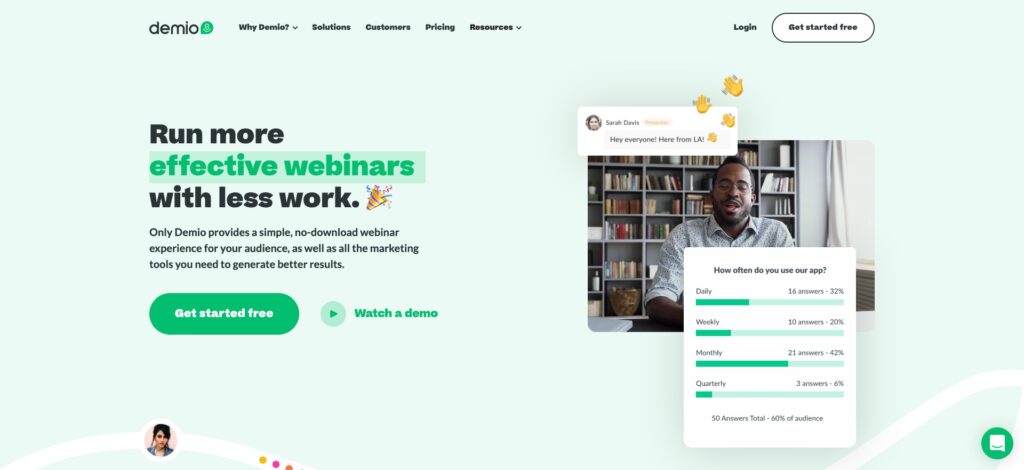
Some other features to consider: video and audio quality, co-hosting capabilities (invite a guest speaker and leverage their domain influence), marketing automation tools, and a number of attendees.
- Social media posts
While bloggingisa great way to attract traffic, it takes time to rank on Google. In the meantime, you can leverage social media to attract new leads.
Here are some basic principles for your social media strategy:
- Align your content with the target audience expectations
Learn which network is best suited for what. Posting funny pics that would be more appropriate on Facebook on LinkedIn will get you muted or even unfollowed.
- Be consistent in your content updates
If you don’t have the resources to actively engage on all of the networks your potential customers use, choose one or two, but always be ready to offer advice or respond to criticism. Nothing is worse than having an account on a social network and ignoring your subscribers’ comments.
- Analyze your competitors’ social media strategy but don’t copy it
Some of the tools to help you with competitor analysis, content scheduling, and influencer research are CoSchedule, SproutSocial, HubSpot, Hootsuite, Buffer, and the like.
- Maintain a consistent visual style
You will likely be competing with hundreds of accounts for your potential customer’s attention, so make sure your brand voice stands out by developing a unique visual style (colors, fonts, templates). Using online services like Canva, Visme, Pixelied, or VistaCreate can facilitate the process while lowering costs.
Don’t follow the trends to the letter but keep it up-to-date. When everyone uses the same font, how are people going to tell you apart from your competitors?
- Pinterest pins
Pinterest is a somewhat underestimated visual search engine/network. With over 1,9 billion monthly organic visits, according to the online visibility management platform SemRush, Pinterest is a perfect place to tell your brand’s visual story.
According to Pinterest, 97% of all searches are unbranded, which means that the audience is still at the top of their decision funnel, and you can capture their attention and convert them to customers. Unlike Instagram, Pinterest allows you to directly link each Pin to your website, making it an invaluable source for traffic and leads.
According to Statista, 40% of Pinners in the US have over $75 000 annual income, which is higher than the national average.
And, contrary to a popular misconception, Pinterest works well not only for recipe, fashion, and home decor blogs but also for other niches, including finance, coding, DIY, parenthood, fitness, and lifestyle.
Key metrics to track for TOFU content
To analyze the effectiveness of your marketing efforts, keep track of website traffic (page views, time on site, impression by channel), social reach, email subscribers, and inbound links.
Stage #2 – Interest and Evaluation (Mid Funnel Marketing, MOFU)
Congratulations, you’ve made it to the interest and evaluation stage. You created awesome content, distributed and promoted it correctly, and now potential customers know you exist.
Some of them may have visited your website or even subscribed to your newsletter or followed you on social media. You are gaining interest. What can you do to keep them interested until they move to lower funnel marketing?
Your prospect’s goal: Identify products or services that are likely to solve their problem and start evaluating them.
For example, a prospect looking to start a blog has decided to build a blog on WordPress instead of using a website builder service like Wix. At this stage, they’ll be comparing different popular hostings like A2Hosting, BlueHost, Kinsta, WP Engine, or HostGator, for example.
Your goal: To convince potential clients that your product/service is the right solution for their problem.
Marketing channels to use: Email marketing,advertising (both text and display, especially retargeting), social media, SEO, SEM.
Types of content for Mid-Funnel (MOFU) marketing
If the TOFU marketing is all about generating leads, MOFU marketing focuses on nurturing those leads.
The content you create for MOFU marketing should serve these goals:
- Educate. Your prospects are likely to have multiple questions at this point. Answer those questions, explain how your product solves their problem, and provide evidence.
- Differentiate. Show potential customers what sets your brand apart from the competition by highlighting your unique selling proposition.
- Convince. Personalize your content to match your potential customers’ needs and persuade them to take action (register an account, sign up for a newsletter, etc.).
You can achieve these goals through a variety of content types and distribution channels.
There is no “one size fits all” formula, but these content types work for most companies:
- Blog articles (how-tos, guides, reviews, comparisons)
- Educational content (e.g., whitepapers, case studies)
- Landing pages with robust product descriptions
- Email opt-ins using lead magnets (e.g., e-books, whitepapers)
- Free trials
- Webinars
- Case studies
- FAQ pages
How Do You Know What to Post on Your Blog
TOFU content is all about introducing your product and building a trustful relationship with potential customers. In contrast, MOFU content should reinforce that relationship and establish your company as the go-to resource for customers who are still looking for a solution that meets their needs.
Your MOFU content should demonstrate your company’s subject-matter expertise and show the value your products provide, not just list the product features.
Here’s what you can blog about when you are writing for mid-funnel customers:
- How to use your product
- How your product solves a specific problem
- Unique ways to use your product
- Why your product is better than that of a competing brand
- What makes your company unique
If you struggle to come up with specific content ideas, you can use this topic research tool from SemRush to discover what’s trending now in your industry and turn it into an actionable plan.
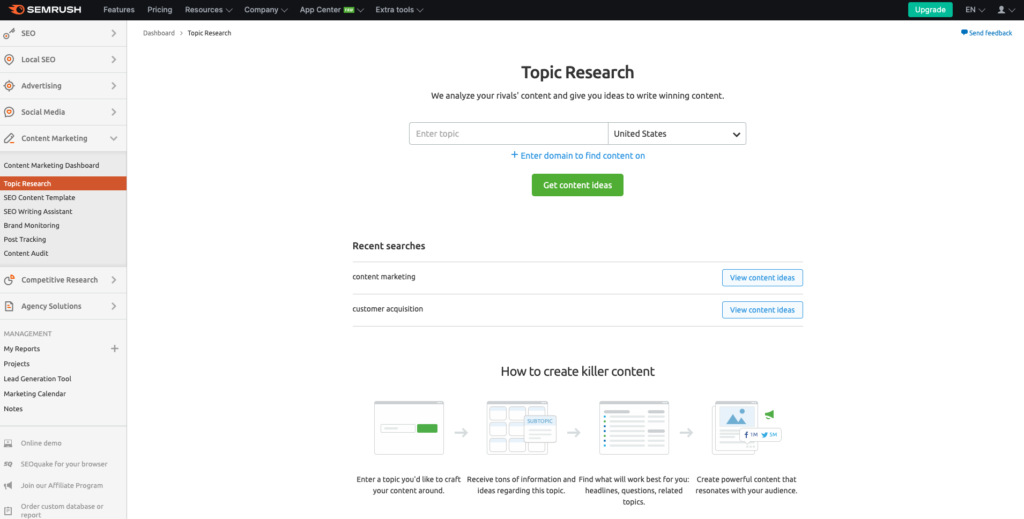
Besides topic research, SemRush provides a few tools that help build a content marketing strategy: keyword research and analysis, competitor research, content strategy builder, etc.
CoSchedule is another popular content marketing platform for businesses used by over 55 000 marketers, including those at Forbes. CoSchedule offers multiple agile tools to plan, create, analyze, improve, and schedule marketing content and social media campaigns in one place.

Their main product (“Marketing Calendar”) is priced at $29/month when paid annually (they do have a 14-day free trial), but they also offer a free online tool called Headline Analyzer.
This AI tool suggests changes you can introduce to blog headlines (word count, emotion words, clarity, etc.) to increase traffic and social shares. Headline Analyzer can be used as an online tool or as a browser extension.
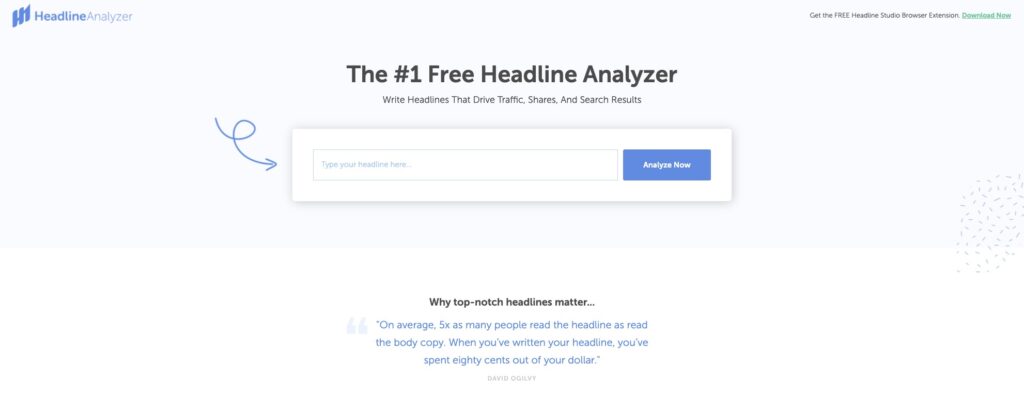
Key metrics to track for MOFU content
The primary purpose of the mid-funnel marketing efforts is to nurture leads and make them proceed to the decision-making stage, so you need to quantify and analyze the efficiency of such efforts.
Track engagement metrics (bounce rate, click-through rate (CTR), referral traffic, returning visitors, etc.) and purchase intent metrics (newsletter sign-ups, lead magnets downloads, webinar participants, etc.).
After posting content on your website or social channels, check how it performs monthly, quarterly, and yearly. Noticed that the performance of certain pieces of content is declining? Analyze the reasons and then update, merge, or delete underperforming content.
Stage #3 – Decision and Action (Bottom Funnel Marketing, BOFU)
As we approach the bottom of the marketing funnel (BOFU), the funnel becomes even narrower. At this point, prospects are seriously considering purchasing your product.
Your prospect’s goal: Decide which of the competing products best meets their needs. As part of the decision-making process, the second step is to choose the appropriate version of the product (e.g., a basic or professional pricing plan for a SaaS product).
Your goal: Provide final pieces of information to persuade the prospect to buy from you and inspire confidence in the customer’s purchasing decision.
Types of content for BOFU marketing
These types of content can help you convert prospects to customers:
- Videos and photos of the product in action
- “Behind the scenes” content
- Case studies
- Inventory specific advertising (e.g., location-based)
- FAQs
- SEM
- Coupons/discount codes
- Customer success stories
- Customer reviews
A few notes here: some companies are making everything possible, even resorting to unethical practices, to get only positive reviews from their customers. But a few negative reviews isn’t necessarily a bad thing. Having a variety of balanced positive and negative reviews increases their validity and trustworthiness.
What matters to potential customers reading negative reviews is how the company reacts to them: do they offer help and compensation for inconvenience, or simply ignore or reply with a copy-and-paste answer?
“Behind the scenes” content might include, for example, personal stories about the company’s founders, photos from the office, etc.
You may think that talking about your founders or why you started the company would be an awareness piece, but it actually adds value to the bottom of the funnel marketing. Customers want to know if you meet their ideals or can relate to them. Highlighting your company’s heritage, its efforts to be carbon-neutral, or that you are female-led and owned helps customers move you from consideration to decision.
Post-purchase customer experience
Congratulations, your marketing funnel worked like a charm, and you got yourself a new customer. Once you’ve done that, focus on keeping your customer for repeat purchases, upsells, and cross-sells.
You will need new funnels for that to happen, but current customers will reach the decision-making stage faster since they already know, like, and trust you. Keeping a customer and getting them to purchase again is more straightforward than finding new prospects.
Providing customer service content, implementing loyalty programs, reward points, and referral programs keeps your marketing spend low. With time and some effort from your side, repeat customers can become brand advocates and thus will bring even more value to your company.
Did you find this article helpful? Please share it on social networks to help your fellow marketers!
